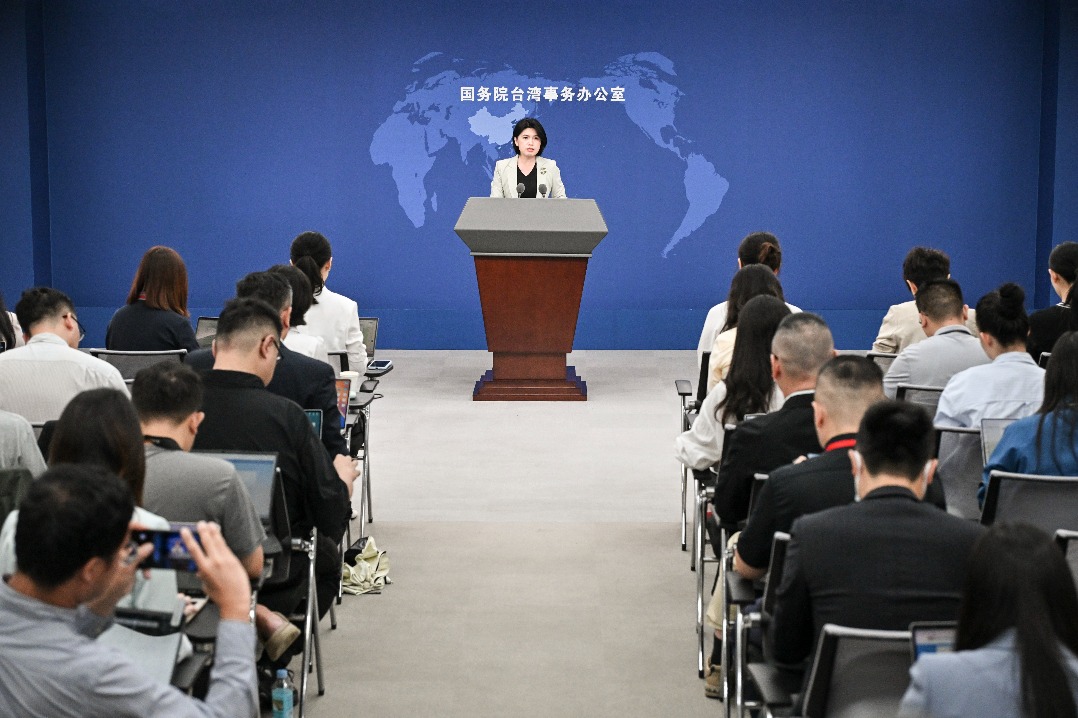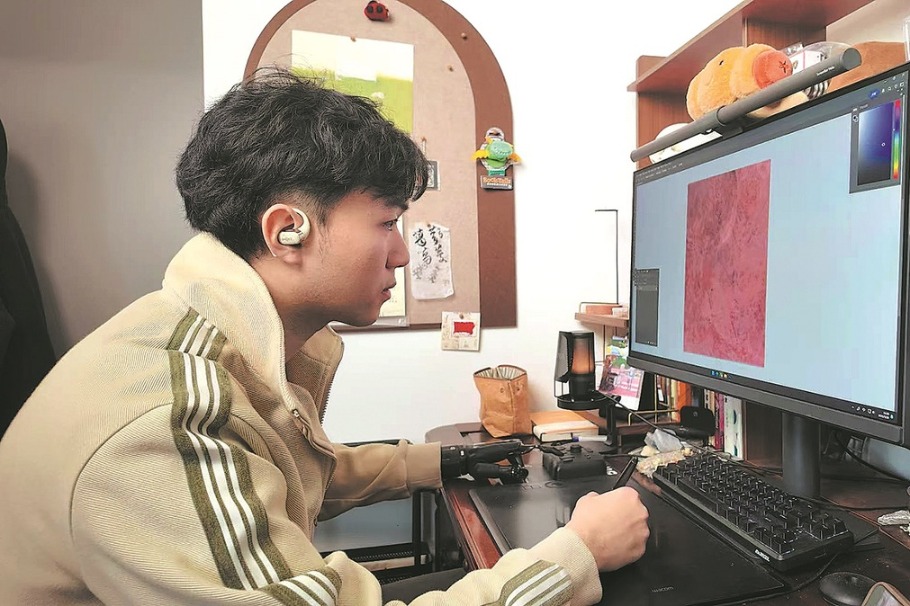A man with time on his hands
Palace Museum clock restorer cherishes every hour spent bringing mechanical masterpieces back to their original condition, in a job where every second counts, Wang Qian reports.

At Beijing's Palace Museum, it sometimes seems that time stands still, but the clocks keep ticking at a small workshop. This is where clock conservator Qi Haonan works. As the fourth generation to repair and restore antique clocks at the museum since the founding of the People's Republic of China in 1949, Qi has returned more than 100 timepieces to their former glory. The museum houses over 1,500 antique timekeepers.
"Restoring such clocks doesn't mean to make them look brand-new. Through cleaning and restoration, I try to keep the antique clocks in their original form, bringing back their mechanical and performance functions," the 41-year-old watchmaker says, adding that it usually takes months-sometimes up to a year-to completely restore a clock.
He still remembers the excitement when the hands of his first repaired clock began to move. It was a French clock with a barometer built into it, which took him a month to restore.
"What amazes me most about these clocks is that they combine the scientific advances, technological precision and the trend in decorative art of their particular era. I want to enable more people to marvel at the mechanics," Qi says, adding that through short-video platforms, he can share with a wider audience just how magnificent the clocks are when they are fully functional.
He started posting videos about the antique clocks on the social media in 2019, giving viewers a glimpse into the complicated and playful world built by horologists since the 1600s. His Sina Weibo account has attracted nearly 3 million followers. On short-video platform Douyin, Qi's account has more than 310,000 followers, garnering over a million likes.
One of the most clicked videos features the most complicated clock that Qi and his mentor Wang Jin have repaired. Made by a Swiss horologist in 1829, it is an automaton-equipped gilt copper clock. The video shows how the mechanical characters perform movements to the sound of the chimes.
The clock consists of more than 1,000 components with seven sets of gear transmissions. It features a magician's stage with an automaton performing a conjuring trick with cups and balls inside a temple and a singing bird standing on top.
From Qi's experience, it is one of the two most sophisticated clocks that he has seen in the Palace Museum. The other is an automaton clock that has a robot writing Chinese characters with a brush.
"These clocks are rare treasures, not only serving as a plaything for emperors, but also witnessing the development of the mechanical loom," Qi says.
Since the reign of Emperor Qianlong (1711-99), many European-made clocks (most of which came from the United Kingdom, Switzerland and France) were donated to, or ordered by, China's royal families, whose interest in these exotic machines lasted until the final days of the Qing Dynasty (1644-1911).
During the rule of Emperor Kangxi (1654-1722), an office for clock manufacturing was established with Jesuit clockmakers given the responsibility of maintaining the court's various Western clocks.
Just like clockwork
Born in Beijing in 1981, Qi graduated from the capital's North China University of Technology in 2004. Majoring in mechanical automation, he became an intern at an internet company, but quit the job due to its heavy workload.
"When I heard there was a job opening at the Palace Museum, I decided to apply," Qi says, adding that visiting the museum's gallery of clocks reinforced his decision.
"These timepieces opened my mind to clocks. They are mechanical wonders combining technology and art," he says.
In 2005, he joined the cultural relics restoration department at the Palace Museum, becoming an apprentice of Wang, the museum's third generation watchmaker.
"In the beginning, everything in the palace was fresh to me. It made me excited to even think about repairing vintage clocks," Qi says.
But reality soon dampened his enthusiasm. There is an apprenticeship rule: For the first year, you can look, but don't touch.
From 8 am to 5 pm every day for that first year, Qi checked and dismantled watches and clocks collected from friends to practice detecting defects. It took him a year of this repetitive routine before he could finally get his hands on the small French clock in the museum.
"It is a job that requires extreme patience, because clock restoration is a tedious and meticulous process," he says, adding that it is proof positive of the proverb "haste makes waste" and, in this case, haste can do a great deal of damage.
Although the antique clock repairing techniques at the Palace Museum were listed as a national intangible cultural heritage in 2014, it was a little-known skill and in short supply of career candidates before 2016, when three-part TV documentary, Masters in the Forbidden City, thrust the profession into the national consciousness.
"Before the release of the documentary, for a decade it had just been Wang and I doing the job," Qi says, adding that they tried to recruit graduates from college, but nobody applied.
Qi didn't expect that the documentary would make that profession a viral sensation. As a result, in 2017, Qi got two apprentices and Wang got three.
Passing down the skill
"With the rising attention and influence, antique clock restoration can not only be further developed, but also be expanded to more museums that house antique clocks and watches," Qi says.
According to Qi, as well as the Palace Museum, the Chengde Mountain Resort, the Shenyang Palace Museum, the Summer Palace-all former properties of the Qing Dynasty royal family-and the Guangdong Museum, among others, have collections of clocks and watches, but they didn't have in-house horologists.
In 2017, sponsored by the Ministry of Culture and Tourism, the Palace Museum launched a two-month antique clock restoration program for workers at these institutions. Then, since 2018, the Palace Museum has carried out joint workshops with several museums, during which, Qi and his colleagues visit these museums and help repair the timepieces while training the in-house team.
"Take the Chengde Mountain Resort, for example. We have helped restore 28 of the more than 50 timepieces in its collection," Qi says.
The effort of Qi and his colleagues led to an exhibition, Sounds of a Prosperous Age: Timepieces in the Collections of the Forbidden City and the Mountain Resort, which opened in January at the Palace Museum. Later this year, it will move to Chengde, Hebei province.
"The collaboration helps the museums set up a communication and resource sharing platform for antique timepieces," Qi says, adding that an archive on clock restoration has been established, comprising photos and texts about the restoration process.
Based on the archive, three books were published, introducing the history, mechanics, design and characteristics of antique timepieces made in the UK, Switzerland and South China's Guangzhou in Guangdong province.
While making antique clock restoration more widely known, Qi has been impressed by the new watchmakers in the office, who have adopted their own fields of research.
"I have two apprentices. One has an expertise in wood carving and the other in sculpture," Qi says, adding that these skills make them good at restoring the ornamental aspects of the timepieces.
They will have plenty of time to practice their skills, because among the timepieces housed at the Palace Museum, there are around 300 that have yet to be touched.






Today's Top News
- Tajikistan looks to China for deeper ties
- High-tech manufacturing lifts industrial profits
- Avenue blooms with flowers to mark victory
- Mainland slams DPP for distorting WWII history
- Northeast Asia trade in focus at Jilin expo
- Organic agriculture forum unites global experts in Datong






























